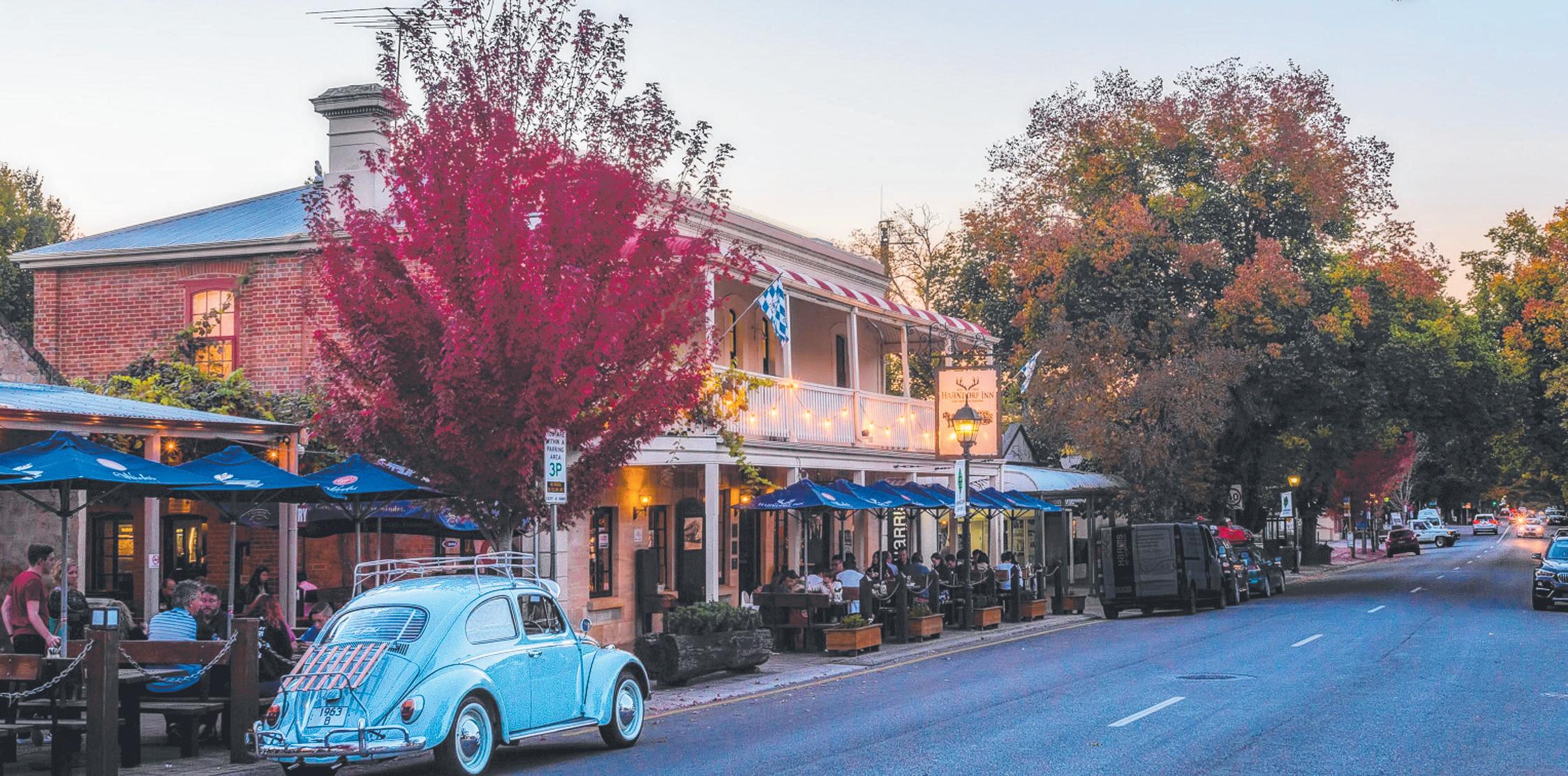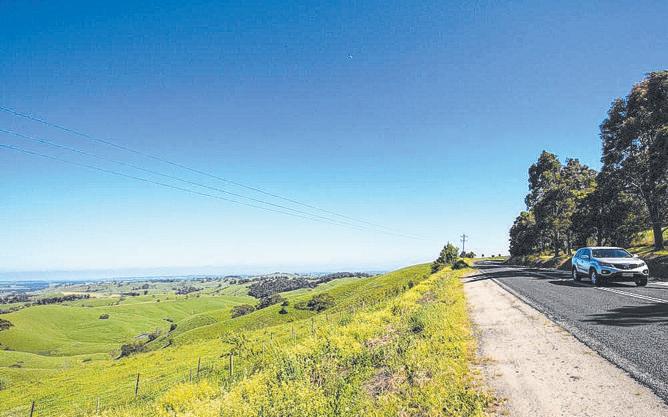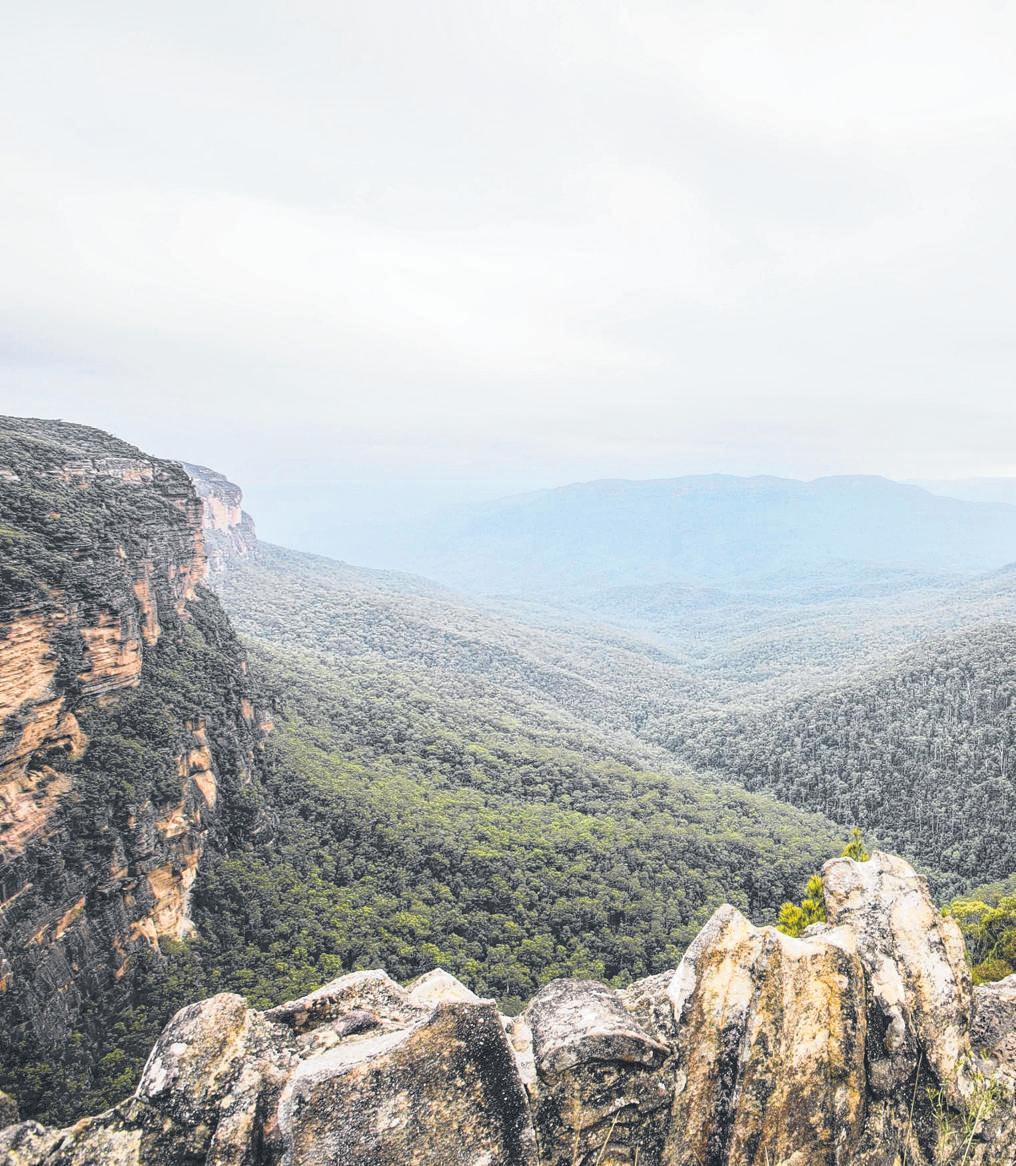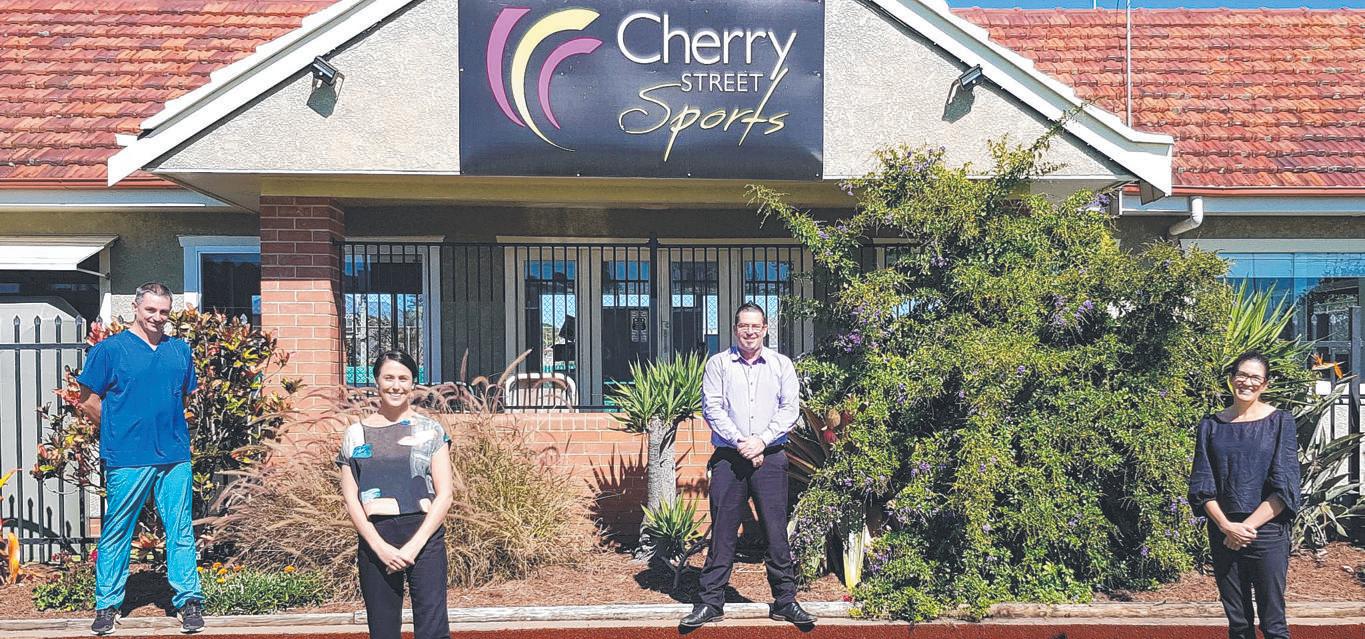
15 minute read
Wanderlust
from Seniors Northern NSW
by seniors
14 ESCAPE Scenic spell on wheels mapped out
Hit the road to help ravaged towns rebuild
Advertisement
Vicki Fletcher
AFTER the fires, floods and storms at the start of the year, Tourism Australia’s campaign to Holiday Here This Year had us all filling our calendars with good oldfashioned Aussie road trips.
Now all those plans are on hold, we’ve unfolded the map and are instead busy marking tiny towns with the best bakeries and lookouts from which to watch the sunrise, and calculating the most scenic route from A to B.
We’ve enlisted the help of our Flight Centre Australia travel experts, seeking tips about which areas affected by the fires and floods to visit... when we’re all free to travel again, of course.
Remember to keep an eye on national initiatives like Roadtrip For Good, which has pulled together a host of places to eat, drink and visit in fire-affected areas.
For now, stay home and stay safe. We’ll be travelling again soon.
NSW SOUTH COAST
All the regions that were hit by fires rely on the tourist trade and the South Coast of NSW is no different.
It is flanked by the Great Dividing Range on one side and ocean on the other.
The fires burned through a lot of bushland, including national parks and state forests, cutting many communities off for days.
Now the roads are open again, there are many hidden towns and coves to explore on a trip south through the Shoalhaven and Eurobodalla area.
Ulladulla local and Flight Centre Ulladulla team leader Janice O’Neill is passionate about getting people back into the area. Just over three hours’ drive south, the hilltop town of Milton is a charming introduction to the picturesque region. Janice suggests stopping at Pilgrims, a delicious vegetarian cafe, and wholefoods store, or the Milton Farm Shop for local produce and specialties. There are also some great boutiques to check out, including Spaces 2538 and AKWA Surf.
In Ulladulla, Janice suggests dining at Native Cafe overlooking the harbour, Rapt Bratz to pick up cool kidswear, Sol Sisters Artisan Collective for clothes, homewares and jewellery, plus Dwell 35 South and Coyote Boutique.
Don’t miss Cupitt’s Estate, a winery-cum-brewery-cumfromagerie on the edge of town, which Janice recommends for a long lunch.
In Burrill Lake, you can’t go past The Fish Shop for fish and chips, and Holiday Haven at Burrill Lake hosts live music by the lake each Saturday during summer.
BATEMANS BAY TO EDEN
Once you hit Batemans Bay you’re in the real heart of the South Coast. Nicole suggests stopping in for a spot of shopping at local boutiques Forever Fashion, Brooke’s Place, Sirens, Journey Style and Homewares, and many more.
The Princes Highway south from Batemans Bay all the way to Eden winds through many quaint towns, making up a huge stretch of coastline that’s been affected by the fires.
Worthwhile stops along this route include:
Mogo, a tiny town with a main street lined with boutique stores and cafes, plus the award-winning Mogo Zoo, which supports a range of endangered animal species.
Bega, famous for its cheese brand, is another regional hub worth stopping at for the Bega Cheese Heritage Centre and the Bega Valley Regional Gallery, home to one of Australia’s richest portraiture awards.
BLUE MOUNTAINS, NSW
From Sydney, head northwest through Richmond to the Bells Line of Road, which will take you on a loop of the Blue Mountains.
While it’s possible to do some of these spots in a day, a long weekend will really allow you to make the most of the mountains’ beautiful towns and grand valleys.
The first half of the journey takes you along one ridge line through Bilpin, Mount Wilson and along to Lithgow. From Lithgow you loop back east along a more southern ridge line.
You can also take the train from Sydney all the way to Mount Victoria. Buses are currently replacing trains between Mount Victoria, Lithgow and Bathurst due to fire damage on the tracks.
Where to stop: Bilpin to Lithgow
Bilpin is known for its orchards, and while there won’t be as much fruit to pick this year given the damage to trees, you can still feast on a famous apple pie from the Bilpin Fruit Bowl, drink cider from Hillbilly Cider or Bilpin Cider Co, and buy local products like apple cider vinegar at Wirraninna Ridge.
Just past Bilpin you’ll find Blue Mountains Glow Worm Tours at Berambang.
In Lithgow, dive into the region’s history at Esbank House and Museum and the Lithgow State Mine
OLD-WORLD CHARM: Hahndorf is a pretty town in the Adelaide Hills, South Australia. Picture: SATC/Michael Waterhouse
Museum.
For a dose of nature, head to Hassans Walls Lookout, the highest in the Blue Mountains, easily accessible just a few minutes’ drive from Lithgow.
Where to stop: Lithgow to Leura
The first stop is Mount Victoria, a historical centre in the mountains, with the historical society museum.
In Blackheath, book in for a meal at the one-hatted Fumo, serving up modern Japanese.
In Katoomba, you can’t miss the iconic Three Sisters, or a day at Scenic World exploring the beautiful bushland via the Scenic Railway, Skyway or Walkway.
For bushwalking, head to Wentworth Falls, which escaped the blazes and where so many trails remain open.
Always check local council and national park websites for the latest closures.
GIPPSLAND, VICTORIA
The vast Gippsland region, east of Melbourne, is a rich farming area home to dairies, wineries and hundreds of small producers – the kind of businesses that rely heavily on tourist traffic and local visitors.
On a road trip from Melbourne you can head north to the Alpine High
Grand Ridge Road, in the vast Gippsland area of Victoria. Picture: Josie Withers/Visit Victoria

Country and Snowy River Country regions, or east to the Gippsland Lakes Region and the Coastal Wilderness Region.
Things to do in Northern Victoria:
Visit King Valley at Whitfield, home to a range of wineries and breweries such as La Cantina Winery, King River Brewery, Dal Zotto Wines and more.
Stop off to pick up goods from local producers around Milawa, such as the Milawa Cheese Factory and Milawa Mustards, and head further north for the Tolpuddle Goat Cheese Farm in Tarrawingee.
Head to Bright for country hospitality and a range of boutiques, breweries, coffee roasters and cafes, including Bright Brewery, Sixpence Coffee, and Gingerbaker.
Beechworth, further north, is a quintessential country town with gorgeous architecture, museums, mountain biking and bushwalking.
Things to do in Eastern Victoria:
Make your first stop in Paynesville, home to plenty of eateries such as Bullant Brewery and The Old Pub Paynesville.
From here you can head to 90 Mile Beach or Raymond Island – home to the Koala Trail.
The Lakes region is home to a network of lakes and lagoons, and to wildlife including lake dolphins and pelicans. The Mitchell River Silt Jetties are also a highlight, being the longest silt jetties in the world.
ADELAIDE HILLS, SOUTH AUSTRALIA
A stone’s throw from South Australia’s capital, the Adelaide Hills offer the perfect day or weekend trip
‘‘

out of the city. Alyx Cauchi, team leader of Flight Centre Mount Barker in the Adelaide Hills, says there is plenty to see and do.
“There are so many wineries still open. New Era Vineyards in Woodside is open, though it was almost destroyed, and next door, Bird in Hand was hardly touched. Shaw + Smith is also great – there are heaps (of wineries) open and they need your business,” Alyx says.
The region is also known for its food, so why not turn your mini break into an epicurean adventure.
Be sure to check out:
The Adelaide Hills Wine Region Facebook page has updates on wineries as well as events, such as the annual Crush Festival in January.
Cleland Wildlife Park, home to rescued native animals, is great for families.
“The park wasn’t affected by the fires, but the vet and keepers have been doing amazing work helping with emergency wildlife cases from the fires,” Alyx says.
Big Rocking Horse in Gumerancha is also worth a visit with kids, as is Melba’s Chocolates in Woodside for a sweet treat.
“It’s about getting out and supporting the community as much as we can. There is so much to see and do, and the Adelaide Hills will welcome you with open arms,” Alyx says.
KANGAROO ISLAND, SOUTH AUSTRALIA
Long lauded for its natural beauty and unique and varied wildlife, Kangaroo Island is the gem in South Australia’s crown of tourist hotspots.
The fires here were devastating, particularly in the southwest, affecting much of the island’s unique wildlife. However, Sameer Roopawalla, Flight Centre South Australia Kangaroo Island expert, says the fires affected less than half of the island’s total area, which means there is plenty that remains open for business.
From Adelaide, it’s just over 90 minutes’ drive south to Cape Jervis. From here you can hop aboard the Kangaroo Island car and passenger ferry.
What to do on a day trip:
Upon arrival at the island you’ll land in Penneshaw, a quaint village filled with charming pubs and restaurants.
For a day trip, Sameer recommends exploring the most eastern part of the island.
In Penneshaw, visit the Maritime and Folk Museum and see the little penguin colony, best viewed at sundown.
Head east along the coast for wine tasting at Dudley Wines.
Further east you’ll find Cape Willoughby Lighthouse, South Australia’s first lighthouse.
There are guided tours of the lightstation, bushwalks for all levels of fitness, and whale watching between May and October.
For more great Australian road trips, check out self-drive holidays: go to flightcentre.com.au.
Scenic views of the Jamison Valley and Blue Mountains National Park from Wentworth Falls, NSW.


16 MAY, 2020// SENIORS ESCAPE PALLIATIVE care is personand family-centred care provided for a person with an active, progressive, advanced disease, who has little or no prospect of being cured and who is expected to die. The primary goal is to optimise the quality of their life.
End-of-life care is provided in the last few weeks of life, when a patient with a life-limiting illness is rapidly approaching death.
The needs of patients and their carers are higher at this time. This phase of palliative care is recognised as one in which increased services and support are essential to ensure quality, co-ordinated care from the healthcare team is being delivered.
This takes into account the terminal phase, or when the patient is recognised as imminently dying, death and extends to bereavement care. Palliative care helps people live as fully and as comfortably as possible when living with a lifelimiting or terminal illness.
Palliative care identifies and treats symptoms, which may be physical, emotional, spiritual or social.
Because palliative care is based on individual needs, the services offered will differ but may include: • Relief of pain and other symptoms, such as vomiting and shortness of breath. • Resources such as equipment needed to aid care at home. • Assistance for families to come together to talk about sensitive issues. • Links to other services such as home help and financial support. • Support for people to meet cultural obligations. • Support for emotional, social and spiritual concerns. • Counselling and grief support. • Referrals to respite care services.
Who is palliative care for?
Palliative care is for people of any age who have been told they have a serious illness that cannot be cured. Such care helps people who have illnesses like cancer, motor neurone disease or end-stage kidney or lung disease to manage symptoms and improve their quality of life.
For some people, palliative care may be beneficial from the time of diagnosis with a serious lifelimiting illness.
This care can be given COMFORTING: Palliative care needs change as the final stage of life unfolds, but the constant focus of healthcare professionals and others is on easing symptoms. Ensuring dignity in final days Palliative care a team approach alongside the treatments provided by other doctors.
Who is in the palliative care team?
Palliative care can be provided by a wide range of people, including your GP, aged care worker, cardiologist and any other healthcare provider, as well as family and other carers.
They are supported by specialist palliative care services if symptoms become difficult to manage.
Where is palliative care provided?
Palliative care is provided where the person and their family want, where possible. This may include at home, in hospital, in a hospice or in a residential aged care facility.
Many people indicate a preference to die at home, and making this possible often depends on several factors: • The nature of the illness and amount of care the person needs. • How much support is available from the person’s family and community. • Whether the person has someone at home who can provide physical care and support.
For more information, contact the palliative care peak body in your state. Go to https://palliativecare .org.au/what-is-palliativecare. AUSTRALIA is pulling out all stops to try to prevent any further surge in coronavirus cases, while also preparing for the possibility that these efforts may not be successful.
As part of that
Essential role of end-of-life support highlighted preparation, decisions are being made about ensuring the appropriate health professionals are available where needed most.
Palliative care is an essential component of the frontline response as the number of Australians dying from COVID-19 continues.
Palliative care can help manage severe shortness of breath, other physical symptoms and distress, and provides personal support for people who are seriously ill or dying, and their families.
It can assist in prevention and reduction of clinical problems in the community and residential aged care, and help to ensure that vulnerable people avoid unnecessary emergency department presentations and hospitalisation.
The president of the European Association for Palliative Care (EAPC), Prof Christoph Ostgathe, has pointed out that during the disordered emergence of this pandemic, many people may not have considered why palliative care is an essential service. However, he warns, palliative care is key. In a recent EAPC statement, he wrote:
“During this crisis, in palliative care we need to step up and ensure that we are proactive; that we fully utilise our well-honed skills and competencies and prove that we are an important part of our hospitals’ and our services’ crisis plans.
“We need to make it clear that in a pandemic like this, palliative care is not a luxury, it is a human right!” – Extract from Palliative Care Australia.
For more information, visit palliativecare.org.au/ covid-19-updates.


SENIORS \\MAY, 2020 Fee-free GP clinic in Ballina

BRAND INSIGHTS
IN RESPONSE to COVID-19, Cape Byron Medical Centre is offering telehealth services for General Practice, Allied Health and Specialists, wherever possible.
GP appointments, as well as physio, dietetics and many specialist appointments, are available to all patients, ensuring the exceptional care offered by all Cape Byron Medical practitioners continues during COVID-19. To assist all local GP practices, as well as local hospitals, Cape Byron Medical Centre, in collaboration with the Australian Government Department of Health and North Coast Primary Health Network (NCPHN), has established the Ballina Respiratory Clinic at the Cherry Street Sports Club.
The fee-free, GP-led respiratory clinic is part of the Federal Government’s $2.4 billion health package in response to the COVID-19 outbreak.
NCPHN CEO Julie Sturgess said the clinic was a great example of local collaboration to support the health and wellbeing of the whole community. The clinic will assess people with respiratory symptoms and, where appropriate, undertake testing to diagnose respiratory cases,
LOCAL SUPPORT: Cape Byron Medical Centre, in collaboration with the Federal Health Department and the North Coast Primary Health Network, has established the Ballina Respiratory Clinic at the Cherry Street Sports Club.
including COVID-19, influenza and pneumonia. Results will be available within one day.
“The clinic will provide the opportunity for people to undergo assessment and testing in a safe environment, close to home, and will protect our most vulnerable community members,” Ms Sturgess said.
“Importantly, it will support local healthcare services, taking the pressure off hospitals and general practices by providing dedicated treatment to people with mild-tomoderate symptoms of fever or sore throat, cough, fatigue or shortness of breath.’’
Dr Tonya Coren, principal GP of Cape Byron Medical Centre, is leading the clinical team co-ordinating the respiratory clinic, which has been established with the highest standards of infection prevention and control and quality assurance. It has private access through a purposebuilt section off the back deck of Cherry Street Sports Club.
Federal Regional Health Minister Mark Coulton said the Ballina clinic would help take the pressure off local hospitals and general practices by providing dedicated treatment to people with mild-tomoderate respiratory symptoms.
“The clinic is part of a range of measures the Australian Government is putting in place, including additional practice incentives and the expansion of telehealth, to enable the rural medical workforce to continue to care for regional Australians through this crisis,” he said.
To book, go to health.gov .au or capebyronmedical .com.au/ballinarc or phone 02 6685 6326. BRC is open Monday to Friday from 9am–5pm.
Cape Byron MedicalCentre –allyourhealth needs in one place
Cape Byron Medical Centre provides a comprehensive suite ofprimaryhealthcare services andsub-specialties.
General Practice
Skin CancerClinic
Physiotherapy
Psychology
Psychiatry
Cardiology
Orthopedic Surgery
Colorectal Surgery
Agedhealth care –facilityandhome visits
Addiction medicine
Indigenous health

Veteran’s health care
Plastic andReconstructive Surgery
Weight-Loss Surgery
Telehealth available




